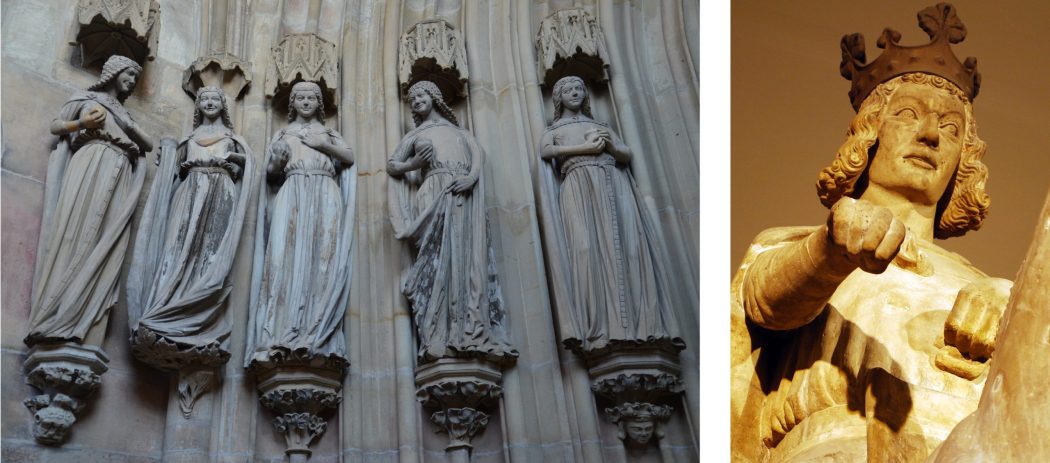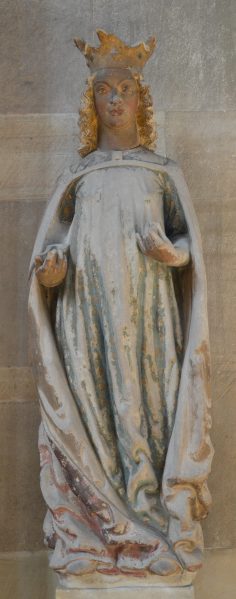Saint Maurice in Magdeburg
Jacqueline E. Jung —
The stunning sandstone sculpture of Saint Maurice made for Magdeburg Cathedral around 1250 – representing the fabled fourth-century leader of the Roman army’s Theban Legion, who allowed himself and his men to be killed for their embrace of the new Christian faith – is justly famous as the first, and arguably finest, depiction of a distinctly African saint in medieval European art.

Although he has hardly gone unnoticed in art historical scholarship – already in 1979 his face graced the cover of the medieval volume of the The Image of the Black in Western Art book series, an honor he’s retained in the revised edition from 2017 – Maurice’s celebrity has increased dramatically in recent years, as medievalists have become more attuned to both the real presence of Africans in European cities and to the applicability of Critical Race Theory to our subjects of study. The literary historian and pioneer in the study of medieval race Geraldine Heng has elegantly demonstrated how, when observed in the context of mid-thirteenth-century imperial and ecclesiastical ideologies in and beyond Saxony, this depiction of the racialized saint reveals itself as a richly multivalent image, capable of drawing viewers back into a historical time and far-off land, pointing them forward into the promise of a truly universal Last Judgment, evoking the ideals of an emperor committed to global expansion, and bolstering the political and devotional interests of the local Saxon church in the present.
I’d like to situate the figure more firmly in its art historical context, by considering first its formal and material qualities and then its relationship with its sculptural pendant, made by the same team, of the cathedral’s co-patron St. Catherine. In two further posts to come, I will place the statue in a broader, if still numerically small, field of sculpted representations of African men on French Gothic cathedrals. For too long, art historical commentaries, when they have considered such imagery at all, have tended to perceive these figures through the lens of modern stereotypes, imputing to medieval viewers the same kinds of racist baggage that white Europeans and Americans had developed most concertedly during the eighteenth and nineteenth centuries. With the more nuanced understanding of racial realities and attitudes in medieval Europe our field has gained in recent years, the time is ripe for reconsidering the significance African faces and bodies had in the sculptural world of Gothic cathedrals.
The statue of Maurice, now standing along the south side of the screened choir precinct of Magdeburg Cathedral, retains much of its extraordinary surface detail and polychromy. But the years have not been kind to the figure: a free-standing body unbound to an architectural frame, he seems to have suffered a fall that deprived him of his lower legs; the tip of his broad nose has been broken off; and at some point a certain “H.L.” decided to use Maurice’s forehead as the surface for his own graphic self-commemoration.

Yet the figure’s closed, compact pose – with back erect and shoulders squared, arms pressed tight against his sides, and face directed straight forward – which was enhanced and even determined by his layers of stiff defensive armor, protected him from any further damage. In the stable configuration of his body, its lack of any signs of inner or outer movement, Maurice could hardly be more different from the labile, delicate, affectively nuanced Wise and Foolish Virgins that the same team of sculptors produced for the cathedral’s north transept porch, or from the dynamic equestrian figure of Emperor Otto I (known as the Magdeburg Rider) they fashioned for the town square.

For the more iconic statue of Maurice, the sculptors applied their innovative impulses more to physiognomy than to bodily expressivity. It is not only the polychromy that signals the saint’s distant origins – rich ebony skin setting off lighter grey eyes and deep red lips – but also the sculptural structure of his face. Framed by the roughly triangular opening of his chain-mail hood, Maurice gazes out from alert, focused eyes set beneath a smooth forehead and unperturbed brows (from a distance, the vertical stripes of the graffiti give the brow an impression of tension that it does not in fact have). His heavy lower eyelids yield slight diagonal wrinkles, a stylistic hallmark of this team of sculptors also visible on the Virgins and the Rider, that here lend the face a sense of maturity and a hint of world-weariness. Extending from the base of his wide nose, two nasolabial creases extend down to bracket the soldier’s full, slightly protruding lips. It is unclear whether these are meant to be read as permanent features indicative of mature age or as transient ones, signs that he is momentarily tensing his upper lip. Whatever the case, the overall impression of this face is one of intense alertness and insistent self-control, a mixture of psychological restraint and readiness to act that makes him a perfect protector of the prince-bishop’s ecclesiastical zone.
Maurice, it must be noted, was not the sole saintly patron of Magdeburg Cathedral; that status was shared with the Egyptian virgin-martyr Catherine of Alexandria. She too received sculptural treatment at Magdeburg, in a figure of the same size, materials, and formal composition as the Maurice.

Yet she shares none of the African features or coloration of the soldier saint: her hair falls in shimmering gold-yellow waves around a face with a narrow nose and thinner, if still shapely, lips, and her skin is painted in a peachy-tan color tinged with pink on the cheeks and lips. The lower lids of her blue eyes bulge slightly upward, responding to the pull of her lips as she just barely smiles. Although her arms are positioned as a mirror image of Maurice’s, her bare hands are cupped upward to balance now-lost attributes, and with this open pose, as well as her loose, billowy garment, she forms a complementary opposite to the stern, self-contained soldier.

The interplay of complementary oppositions was often a foundational design principle for Gothic sculptors. This tendency corresponds with the more widespread medieval fascination with the poetics of “contrary things,” so well studied by Barbara Newman – things or ideas that, as the poet Jean de Meun (d. 1305) put it, “are glosses of each other,” such that “whoever wants to define one must bear the other in mind.” In his study of racial imagery in medieval literature, Cord Whitaker describes this sort of mutually reinforcing dialectical play as a “shimmer,” in which “contrariety is central” and “neither whiteness nor blackness stand alone”.
At Magdeburg, Maurice and Catherine materialize this principle beautifully. Like yin and yang, the two face off across the choir area – paralleling the cathedral clergy in their choir stalls – each providing a counterpoint to the other, and equal in their holy status. Black (African) and white (European), male and female, heavily armored and lightly clad, presenting closed and open hands – these are the most obvious visual aspects in which the military saint and virgin martyr shimmer against each other. The figures’ respective accessories, now lost, surely contributed to the dialogue of contraries. It is probable that Maurice’s right hand once held a lance, complementing the sword strapped against his left hip and indicating his preparation for fighting, while Catherine held a miniature wheel in her left hand, as a reference to the violence from which she miraculously was saved. What is clear is that he is portrayed in a kind of eternal present, the state he was imagined to be in before his self-sacrifice in battle – ever armed, vigilant, and ready for action – while she, crowned and lightly clad, has already moved beyond the earthly travails that involved her imprisonment, torture, and eventual beheading.
In the church where they reside, the two saints represent two sides of the same coin: Catherine appears as an embodiment of God’s saving grace, living proof of the power of faith to vanquish external dangers and emerge shining and whole – while Maurice stands as both a formidable protector of the faithful in the here and now and as a reminder of the Christian’s need for self-defense against dangers to the soul. At the heart of the sacred space they wed Ecclesia militans with Ecclesia triumphans in a union that, theologians had long contended, constituted the Civitas dei – the City of God of which the physical church, and the communities of lay and clerical faithful it held, provided a foretaste.
Jacqueline E. Jung is associate professor in the Department of the History of Art at Yale University. Her new book, just published, is Eloquent Bodies: Movement, Expression, and the Human Figure in Gothic Sculpture.

FURTHER READING
David Bindman and Henry Louis Gates, Jr., eds. The Image of the Black in Western Art, Volume II: From the Early Christian Era to the “Age of Discovery,” Part 1: From the Demonic Threat to the Incarnation of Sainthood, new ed. (Cambridge, Mass.: Harvard University Press, 2010).
Heiko Brandl. Die Skulpturen des 13. Jahrhunderts im Magdeburger Dom (Halle: Landesamt für Denkmalpflege und Archäologie Sachsen-Anhalt, 2009).
Geraldine Heng. “An African Saint in Medieval Europe: The Black Saint Maurice and the Enigma of Racial Sanctity,” in Sainthood and Race: Marked Flesh, Holy Flesh, ed. Molly H. Bassett and Vincent W. Lloyd (London: Routledge, 2014), 18-44.
_____. The Invention of Race in the European Middle Ages (Cambridge: Cambridge University Press, 2018).
Paul H. D. Kaplan, “Black Africans in Hohenstaufen Iconography.” Gesta 26, no. 1 (1987): 29-36.
Barbara Newman, Medieval Crossover: Reading the Secular against the Sacred (Notre Dame, Ind.: University of Notre Dame Press, 2013).
Guda Suckale-Redlefsen. Mauritius: Der Heilige Mohr (Zurich: Schnell und Steiner 1987).
Cord J. Whitaker. Black Metaphors: How Modern Racism Emerged from Medieval Race-Thinking (Philadelphia: University of Pennsylvania Press, 2019).


 Deobandism, Islam and the Religious Narratives of the Taliban
Deobandism, Islam and the Religious Narratives of the Taliban